Media | Articles
Renault Clio at 30: Highs and lows of a hot-hatch hero
It’s hard to believe the Renault Clio is maturing into its thirties. The hatchback that seemed so bold and fresh at the 1990 Paris Motor Show is now mellowing into the history books with five generations under its belt, an iconic U.K. TV advertisement to its name, and the honor of being not only Renault’s but also France’s biggest-selling car to date. Oh, and a fair few Renault Sport Clio versions, too.
When it was launched 30 years ago, the Clio replaced the 5 (or, “R5” in Renault-speak) and not before time. By 1990, the ‘”supercinq” felt like the relic of the 1970s that it was, lagging behind in safety standards and creature comforts. Yet such was the popularity of the 5, it would be another six years before the Clio finally killed it off.
The first-generation car is now of an age where a well-preserved, original example could be proudly displayed by its owner at Hagerty’s Festival of the Unexceptional. But even so, there’s no getting away from the fact that one of the keys to the Clio’s success during the past three decades has been the halo cars—the hot hatch versions.
Renault Sport has turned out hot Clio after hot Clio. And with one or two exceptions, they’ve been terrific. Here’s how the Clio has kept gearheads entertained for almost 30 years.
Renault Clio Williams
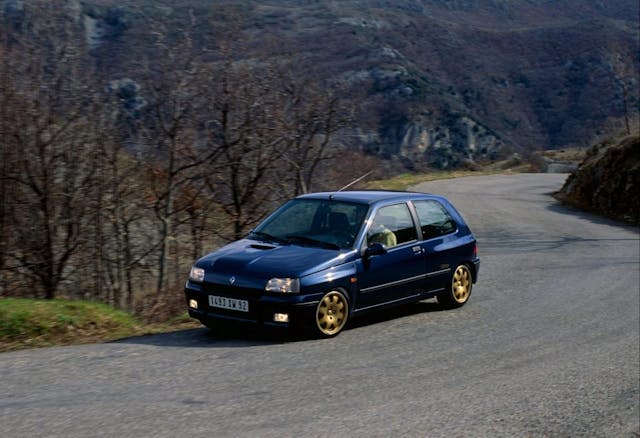
Renault performance fans didn’t have to wait too long for a racy version of the Clio. Twelve months after the launch of the Clio Mk1 came the 16v, with its wider front and rear arches and updated brakes and suspension. It looked the part, and its 135-hp 1.8-liter 16-valve engine was more modern that the 8-valve lump in the Peugeot 205 GTi, and it delivered a winning blend of ride comfort and roadholding.
Marketplace
Buy and sell classics with confidence
However, Renault had more ambitious plans up its sleeve. While the cooking Clios were winning over car enthusiasts, and the mainstream range was being embraced by drivers, in part thanks to the iconic Papa and Nicole adverts created by Publicis, Renault’s ad agency, Renault Sport was brewing up the Clio to go rallying—and the 1993 Williams was the homologated road car.
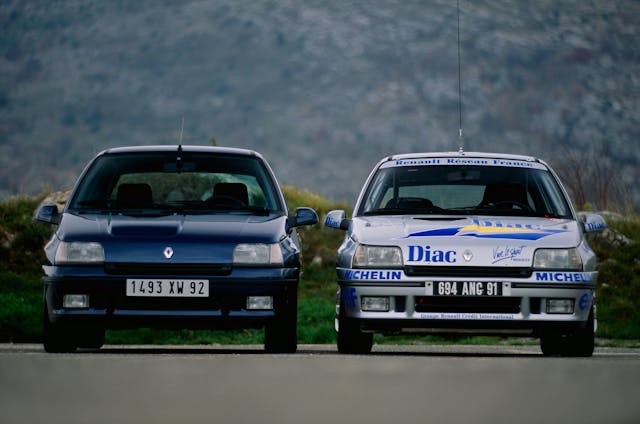
Despite the F1 association, it was a Renault Sport product through and through. Its engineers ripped out the 16v’s 1.8 and installed a 148-hp 2.0-liter, a stronger camshaft, and uprated dampers, springs, and thicker roll bars. They even fitted a reinforced front subframe from the Clio Cup racing car. Renault Sport also ditched the 16v’s electric mirrors, audio system and ABS—something it would follow up in future hot Clios.
The Williams was supposed to be a one-off with numbers capped at 3800, but Renault followed it up with Williams 2 and 3 versions much to the chagrin of Williams “1” owners and in all more than 12,000 were built.
Renault Sport Clio 182 Trophy
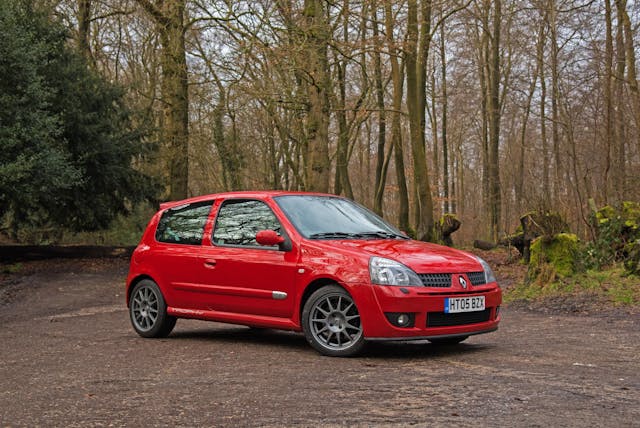
Renault Sport first applied its name to a hot Clio with the Clio II. The 172 of 2000 was an instant hit thanks to a revvy 170-hp 2.0-liter engine, a sharper steering rack and stiffened springs and dampers, topped off with a fine set of 15-inch O.Z. Racing alloys.
A facelifted version arrived in 2001 with some subtle enhancements, followed by the Cup in 2002, which was an exercise in reducing weight and further enhancing the suspension. But the finest hot Clio IIs arrived from 2004. The 182 got an extra 10 hp from the same 2-liter engine and featured xenon lights, climate control and half-leather seats. Various Cup packs were also available. A fully-fledged Cup model appeared in September ’04, but as it only dispensed with the xenon lights, it was barely any more of a featherweight than the standard 182.
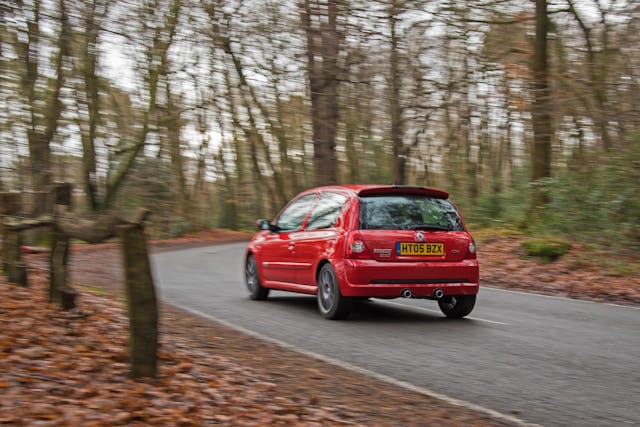
Renault Sport launched its ace card in July 2005 with the Trophy—a 500-unit special that got the full works treatment of Recaro seats, a large rear spoiler borrowed from the Clio V6, lowered Sachs suspension, 16-inch Speedline Turini wheels and, of course, a numbered plaque. It’s seen as a high-water mark not just for Renault Sport but for hot hatches in general. Rumor has it one of the car’s engineers had a Peugeot 205 1.9 GTi in his garage, which says a lot.
Renault Sport Clio V6
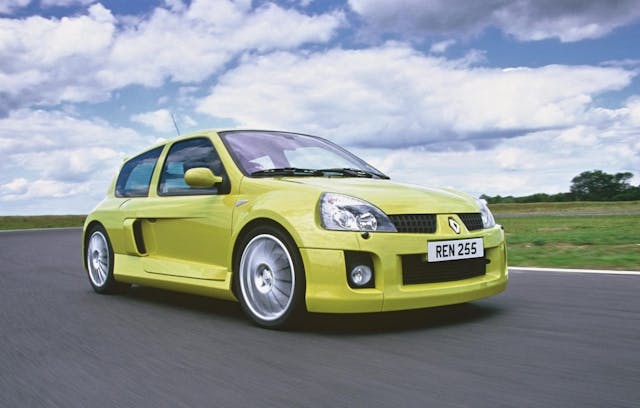
The fact that the Clio II spawned so many performance versions could be a reflection on how mundane it was. Jeremy Clarkson referred to it as a “… very fine washing machine” and later declared it one of the reasons he walked away from Top Gear, in 1998.
Yet Clarkson proved hasty in declaring the car dull. By 2001, the Clio had spawned one of the most outlandish cars of the “noughties,” the Clio V6. With its big arches, mid-mounted engine and rear-wheel drive configuration—not to mention the fact it was built by racing team TWR—the Clio V6 was influenced by the old 5 Turbo and dispensed every shred of the standard car’s gallic rationality. It used Renault’s wailing 230hp 3.0-liter V-6 that pushed out 221 Ib-ft at 3750 rpm, and could launch the converted Clio from 0-62 mph in 6.4 seconds.
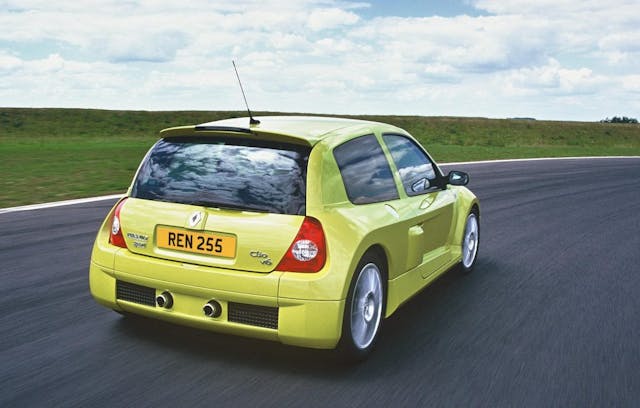
Some 260 V6s were sold in the U.K. before Renault Sport took the project in-house and started to hand build them at its Dieppe factory in 2003. The Phase 2 V6s were tweaked to 255 hp and fitted with a shorter final drive. The U.K. was always the V6’s biggest market and Renault shifted around 340 Phase 2s before canceling the program in 2005, closing the chapter on a cult Clio.
Renault Sport Clio 200 Cup
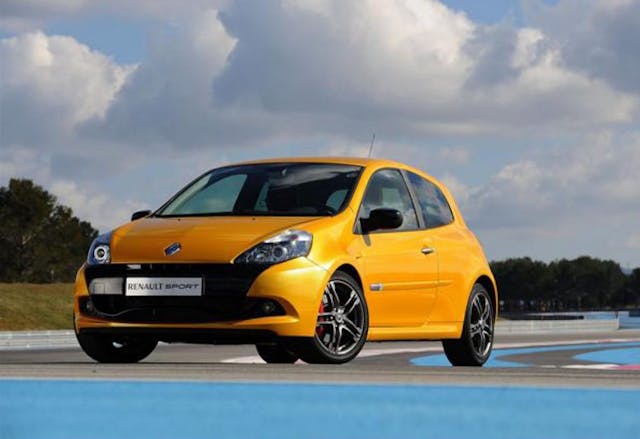
Just like its bigger brother the Megane, the 2005 Clio III had a curvaceous rump and oozed chic that other superminis could only dream of. But while the cooking Clios were cute and cuddly, the Renault Sport 197 was initially met with muted interest. Reviewers were unimpressed by the weight gain over the dainty 182.
Much like with the previous Clio II, Renault Sport fettled and improved the 197 with the Cup and the R27 that dripped with Renault F1 team badges. And just like the 182 Trophy, Renault Sport saved the best until last with the 200 Cup.
Now wearing a more conservative nose in-line with the rest of the Clio range, the 200 had an extra 3 hp but importantly power and output peaked 150 rpm lower than the 197. A new ECU and cylinder head were to thank, and while Renault Sport softened off the regular 200, the Cup was stiffened and the track increased. At the same time Renault introduced what it called an ‘independent steering axis’ that countered torque steer.
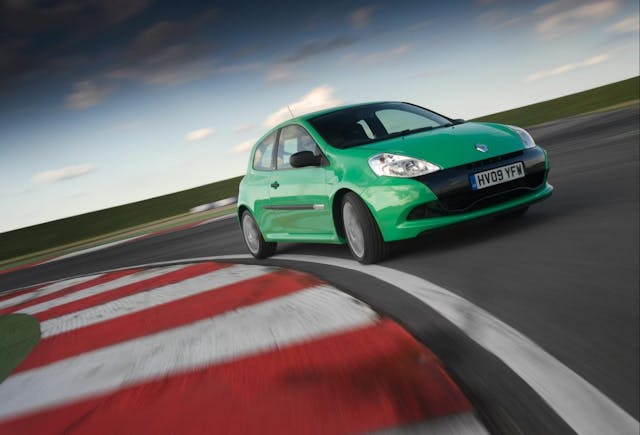
Towards the end of the Clio 200’s life came the Cup-based specials of the Silverstone GP (limited to 50 cars) and the Raider (28 cars), and the luxurious 200-based Gordini which was part of an ultimately unsuccessful Gordini brand relaunch.
Renault Sport Clio 220 Trophy
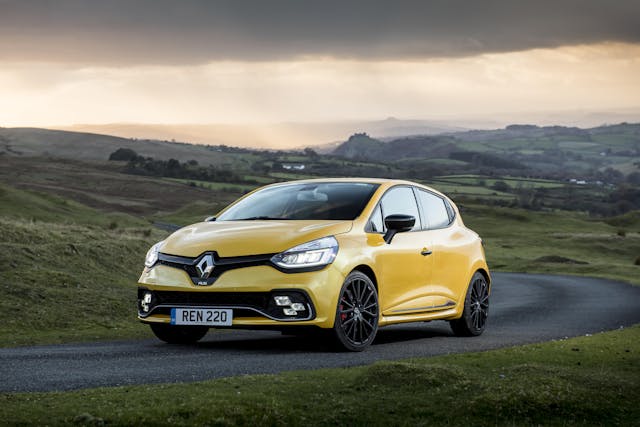
Just like all three previous Clios, hot hatch fans didn’t have to wait long for the Clio IV to pass through Renault Sport’s workshops. The new 200 launched in 2013 and while it certainly looked the part, it immediately met a rough ride that it never truly recovered from.
The Clio IV only came as a five-door hatchback in the U.K., so the 200 took on a more practical character. It also took on a more frugal attitude as the 200 was the first Renault Sport Clio to use a turbocharged engine (1.6 liters), which improved fuel economy and reduced emissions. To top it all, the only gearbox choice was a dual-clutch automatic with shift paddles, and to drown out the engine’s dreary note the driver could choose from an assortment of more interesting engine noises (including the Clio V6’s) to be pumped through the speakers.
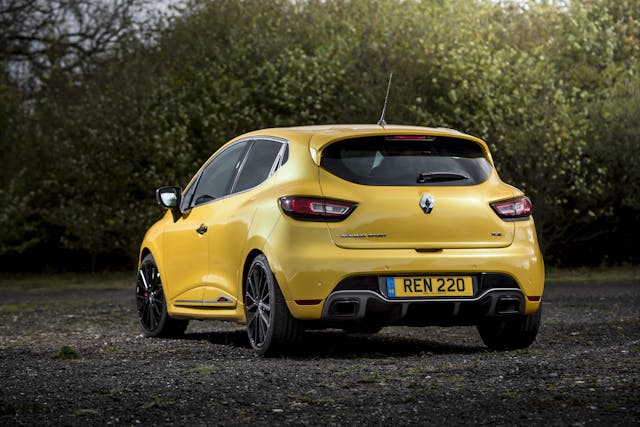
To address criticism, Renault Sport created the 220 Trophy—initially as a special edition, and then in 2015 as a fully-fledged model—with a quicker-shifting gearbox and various suspension tweaks. But it wasn’t enough to trouble the Ford Fiesta ST and the car quietly disappeared in 2019. As the French car maker has no current plans to hand over the latest Clio to Renault Sport, the 220 Trophy appears to be the final chapter in the history of hot Clios.












